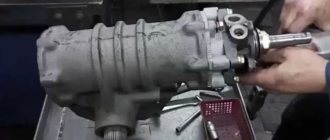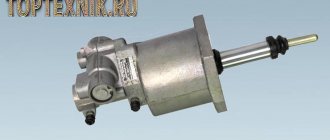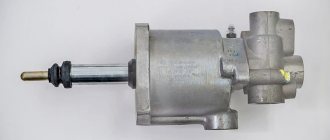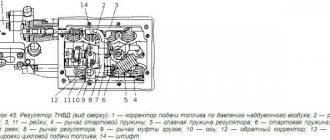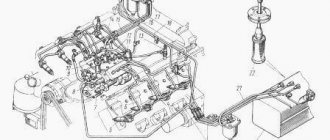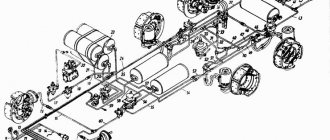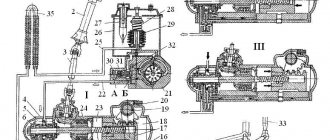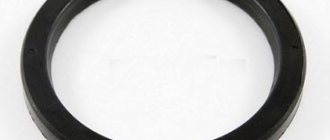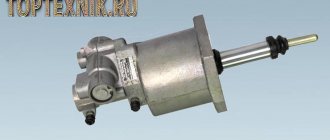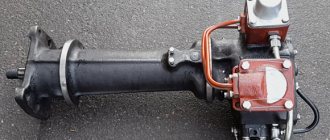Category: KAMAZ
- Purpose of the hydraulic power steering
- KamAZ power steering device
- Power steering pump
- Principle of operation
- KamAZ power steering malfunctions
- Pumping the KamAZ hydraulic booster
It’s hard to imagine how the truck would handle if it weren’t for the KamAZ power steering system. The operation of the parts and mechanisms of this device has become familiar to a heavy unit. The unit helps the user apply minimal force to turn the steering wheel. In addition, a number of complex functions are performed that affect the safety of the machine.
Each mechanism is subject to wear and tear, which will lead to loss of performance. Hydraulic power steering is no exception; the condition of the unit affects other components of the engine. That is why timely maintenance is important to maintain the performance of the amplifier.
The weak link in the steering is the hydraulics. The entry of air bubbles into the channels of the mechanism can stall the work and create an emergency situation. In order to respond to an emergency situation in a timely manner, an experienced user knows how to upgrade the power steering on a KamAZ and restore functionality.
KamAZ-5350:
Purpose of the hydraulic power steering
The purpose of power steering is to reduce as much as possible the user's force applied to the steering wheel. In addition, the operation of KamAZ power steering affects stability when driving at low speeds. When moving quickly, in order to avoid an emergency, the amplifier creates additional resistance on the steering wheel. This stabilizes the ride along the road and keeps it on course.
The peculiarity of the power steering on the KamAZ-4310 and other models is that if the mechanism breaks down or fails, control of the vehicle is not lost, but remains in working order. The only drawback is that the user is forced to turn the steering wheel with greater force when turning the vehicle.
Hydraulic power steering KamAZ-760:
Leakage of working fluid
Very often, power steering malfunctions come down to leakage of working fluid. It can leak in places where pipelines are attached or in case of damage to these pipelines.
In the first case, it is recommended to replace the clamps on the pipelines. If the pipeline is damaged, it must be replaced, which will require draining the working fluid from the system. Moreover, it is advisable to change all pipelines at once. After replacing the pipelines, new fluid is poured into the system and pumping is carried out.
It is important to remember that reusing power steering fluid is not recommended, as this can lead to failure of power steering components. If there is a video in the article and it does not play, select any word with the mouse, press Ctrl+Enter, enter any word in the window that appears and click “SEND”
Thank you
If there is a video in the article and it does not play, select any word with the mouse, press Ctrl+Enter, enter any word in the window that appears and click “SEND”. Thank you.
When filling the KamAZ power steering system with oil or after troubleshooting, it is necessary to remove air from it (“bleed” the steering).
To do this you need:
- Raise the front axle so that the wheels do not touch the ground. Using a jack, place trestles under the beam on both sides. But under no circumstances start pumping with the wheels standing on the ground. Or disconnect the longitudinal link from the steering bipod.
- Remove the pump reservoir filler cap.
- Remove the rubber cap from the steering gear bypass valve and place a transparent elastic hose on the spherical head of the valve, the open end of which is lowered into a glass container with a capacity of at least 0.5 liters. The vessel should be filled with oil to half its volume.
- Unscrew the steering gear bypass valve ½……3/4 turn.
- Turn the steering wheel LEFT until it stops.
- Pour oil into the pump reservoir until the level stops decreasing.
- Start the engine and, while operating at minimum crankshaft speed, add oil to the pump reservoir, not allowing the level to drop until air bubbles stop emitting from the hose placed on the bypass valve.
- Close the bypass valve.
- Turn the steering wheel to the RIGHT until it stops and back to the LEFT position. Keeping the steering wheel in the left position, unscrew the bypass valve ½……3/4 turn and again watch for the release of air bubbles. After the bubbles stop, close the bypass valve.
- Repeat the previous operation at least two times. As a result, clean (without air) oil should come out of the bypass valve. If the release of air bubbles continues, repeat the operation 1-2 more times, while monitoring the oil level in the pump reservoir, maintaining it between the marks on the level indicator.
- Stop the engine.
- Remove the hose from the spherical head of the bypass valve and place the protective cap on it. Check the oil level in the pump reservoir again and, if necessary, add oil. Install the pump reservoir filler cap. If you disconnected the longitudinal steering rod, install it in place.
The process of removing air from the system is complete.
It’s hard to imagine how the truck would handle if it weren’t for the KamAZ power steering system. The operation of the parts and mechanisms of this device has become familiar to a heavy unit. The unit helps the user apply minimal force to turn the steering wheel. In addition, a number of complex functions are performed that affect the safety of the machine.
Each mechanism is subject to wear and tear, which will lead to loss of performance. Hydraulic power steering is no exception; the condition of the unit affects other components of the engine. That is why timely maintenance is important to maintain the performance of the amplifier.
The weak link in the steering is the hydraulics. The entry of air bubbles into the channels of the mechanism can stall the work and create an emergency situation. In order to respond to an emergency situation in a timely manner, an experienced user knows how to upgrade the power steering on a KamAZ and restore functionality.
Power steering pump
The pump is considered the main device of the amplifier, since it creates pressure for the KamAZ power steering, without which operation is not possible. The mechanism is mounted in the area of the power plant frame. The pump is powered by a motor and is driven by a gear transmission. The creation of lubricant pressure in the system occurs due to the blades with which the pump is equipped. The unit performs 2 cycles of fluid intake and release per revolution of the steering wheel. You can also read about the KAMAZ cab tilting (lifting) pump.
Principle of operation
By turning the wheels of KamAZ-5410 and others, the rotor blades perform rotational movements and are adjacent to the stator. The parts that coincide with each other form passages into which lubricant is supplied and passes further due to the resulting pressure. The formed pressure pushes the liquid through the lower valve due to the fact that the oil, at the moment the passages of the distribution disk and the surface coincide, goes beyond the products.
Power steering pump KamAZ-65116, etc.:
The oil enters the rotor blades, having previously passed through the distribution disk. Due to the pressure, the blades adhere more strongly to the stator. The inlet and injection of liquid occurs simultaneously in two directions. An increase in rotor speed prevents the passage of lubricant through a calibrated hole from the area located behind the disk. The resulting pressure acts on the bypass valve, forcing it to open. As a result of valve activation, part of the working fluid passes through the manifold and again enters the suction surface.
KamAZ power steering malfunctions
The advantage of the product is that KamAZ power steering malfunctions appear due to violations of operation and maintenance. Mechanism repair is a rare occurrence, but if breakdowns do occur, they occur at sub-zero temperatures.
Since the amplifier involves mechanics that interact between devices via hydraulics, faults are divided into:
- Mechanical type;
- Hydraulic type.
Replacing the KamAZ power steering oil seal:
Temperature changes negatively affect the hydraulics of the mechanism. Minus values make the working fluid thick, which increases the load on the oil seals and joint seals of the KamAZ-65222 vehicle, etc. The impact of increased pressure leads to oil leaks.
Violation of operating rules negatively affects the components and mechanisms of the amplifier. To extend the service life of the hydraulic booster, you need to take a competent approach to operation. So, leaving the car in the parking lot, the wheels of the vehicle are set to a level position. Otherwise, uneven load on the oil seal will lead to damage.
During the warm season, dirt and dust pose a danger. The penetration of abrasive particles into the mechanism of KamAZ-65117 and other models leads to increased friction and wear of the surfaces of parts. The impact entails depressurization of the system, wear of bushings, rods and other components.
Moisture seeps into the resulting gaps, causing rust on unprotected parts and causing increased wear. Operating the amplifier with similar problems leads to knocking in the steering rack, after which only replacing the KamAZ power steering will help. In order not to go to extremes, you need to tune the amplifier on time. The procedures performed are adjustment and pumping of the device.
Power steering repair
Repair of KamAZ power steering should be carried out by specialists with the necessary skills. It is best to order the service at specialized car services that service KamAZ vehicles or trucks.
Common faults
In general, repair of the hydraulic power steering on KamAZ trucks is required very often, since it is a fairly reliable system. Especially if the rules for using the node are followed and its scheduled maintenance is performed.
Typically, interruptions in power steering operation occur at sub-zero air temperatures, in winter, and during temperature changes. All failures of the KamAZ power steering can be divided into two categories: mechanical and hydraulic (both types of failures can occur in any part of the unit).
The main problem is related to the pump on KamAZ power steering: the viscosity of lubricants increases, which contributes to the squeezing out of oil seals and oil leakage. This malfunction especially often appears on cars that are operated incorrectly, for example, left in a parking lot with the wheels turned out. When starting the engine, the pressure increases only on one side, and the oil seal is squeezed out.
At positive temperatures, interruptions in the operation of the mechanism occur due to dirt and dust that are blown into the system. This leads to depressurization of individual elements, which increases wear on bushings and rods. Rust forms on the latter quite quickly, which also contributes to the rapid wear of the bushings. When using a truck, after 200-300 km, play appears between these parts, which causes a knocking sound from the steering rack. Gear adjustment is also often required.
How to remove an air lock from the system
When refilling with lubricants or after repairs, it is necessary to remove air from the system (bleed the power steering on a KamAZ).
The sequence of actions is as follows:
- Hanging the front axle so that the wheels do not touch the ground. The truck is lifted with a jack and trestles are placed under the beam on both sides.
It is better if this work is carried out by specialists who know how to bleed the power steering on a KamAZ correctly so that there is absolutely no air left in the system.
Replacing parts when repairing power steering
When starting repairs of the hydraulic booster, power steering pump housing and other elements of the system, you need to understand that parts that have exhausted their service life cannot be restored, they can only be replaced with new ones. The production of spare parts with high precision and smooth surfaces is possible only in factories that specialize in the creation of such parts. That is why it is necessary to buy components for KamAZ from reliable companies that supply from official manufacturers.
Adjusting the steering gear
The steering mechanism can only be checked and adjusted in the position when the engine is turned off and the longitudinal steering rod is disconnected.
Before starting work, you need to check the wheel balancing, pressure level, presence of oil in the steering and hubs, settings of wheel bearings and rods, functioning of shock absorbers, quality of installation of the front wheels, oil level in the pump.
To check the force of the steering column, a dynamometer mounted on the wheel rim is used. The force is checked at different positions of the steering wheel: when turning 2 or more turns from the initial position, when turning three-quarters of a turn, when the wheel passes the initial position.
Forces that do not correspond to the specified values in the required positions must be adjusted. This may require dismantling the unit, its partial or complete disassembly:
- First, the adjustment is made in the third position, the adjustment is carried out using the bipod shaft screw;
- Then the first position is adjusted - you need to tighten or loosen the mounting location of the thrust bearings (partial disassembly of the mechanism is required);
- Adjustment in the second position is carried out with complete disassembly of the hydraulic booster.
Source
